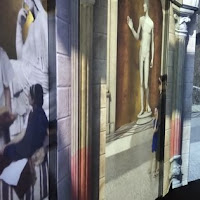In A.D. 79, Italy's Mount Vesuvius erupted. Within 24 hours the cities of Pompeii and Herculaneum were buried under tons of ash and rock, virtually untouched until 1748. Their discovery coincided with the beginnings of archaeology as a real discipline. The hardened ash served as a preservative, allowing archaeologists to see life and death as it occurred on that day. Today, tourists flock to the cities to marvel at the ruins and to see archaeologists at work.
A company called EDG has created a traveling exhibit that incorporates 80 actual artifacts, 10 model reproductions, and videos. In the last year, the exhibit has been in three cities in the United States, and the Orlando Science Center is its last planned stop, through January 24. (https://www.osc.org/pompeii/ )
Visitors begin in a circular room with an immersive video presentation that replicates the disastrous day, and then they move through the exhibits which tell the story of the cities and their citizens.

One sees decorative frescoes, various tools, medical equipment, and other items of their daily life --- even a preserved loaf of bread. The actual artifacts are supplemented by some great working models of ancient technology, like a crane, an odometer, and a model of a villa. Each model is accompanied by an animated video demonstrating how the actual machine worked.
Of course, no Pompeii exhibit would be complete without plaster cast models of the victims, and this exhibit has two. As the ash covered the dead, the bodies deteriorated, leaving cavities which archaeologists filled with plaster. The results are eerie and moving.
Altogether, it makes for an interesting an informative experience.











No comments:
Post a Comment